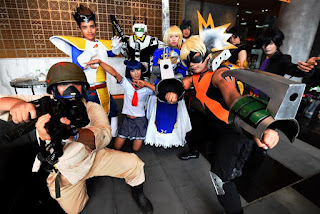Anime Fans
In the United States, the term anime is generally used in reference to Japanese animation, while other countries use a wide variety of non-Japanese-derived terms to describe animation produced outside Japan.
Since the medium of animation was developed in Japan, the region continues to be home to the majority of animation studios in the world. An anime project is often a large production employing a large staff. Both Japanese animation and Western animation are exported by large production houses with other studios, and with studios using all forms of production methods. Some smaller production houses or groups of studios, however, continue to make animated feature films (often employing their own resources and designs, without the involvement of large production houses), focusing on either children's television programming, films for a young audience, or occasionally conventional feature films.
Outside Japan, most of the anime are distributed to television audiences through video-on-demand or cable channels. At times, anime and Western animation have been confused with each other, however the precise difference between the two remains controversial, and in some cases the use of Western animation in the context of anime is entirely unintentional. Many anime fans use either "anime" or "manga" in a single sentence, but "anime" can be used either to mean the art or the original medium, while "manga" may simply mean the illustrated form of the work. The former is normally used in reference to the art itself, whereas the latter is normally used in reference to the short story, novel, comic, or game source material. Some animation enthusiasts use the terms "manga" and "anime" interchangeably as well, but in Japan the distinction is made, with the term "manga" generally referring to the original source material or stories.
The concept of animation in Japan is traced back to its roots in traditional arts and philosophy. The first type of Japanese animation, used for special effects in the Kabuki Theatre, dates back to the 13th century. Many historic Japanese works such as Kanō Chikamatsu's Hyakunin Isshu (The Six Works of a Fool) depict imagery that makes use of the rich tradition of Japanese arts and philosophy. There are also records of animation in China, as well as early examples of animated Chinese films. At the end of the 16th century, a Chinese emperor decreed that an "art of mechanical painting" (qinghua chuangyin) be passed from artist to artist, as part of the exploration of new artistic possibilities.
The earliest records of anime or animated works by modern definition date back to the late Edo period. During this period, artists who received awards for their work were awarded full robes and titles such as kabuki, tajima, and shamisen. This period also saw the development of some modern Westernized techniques, with the help of Westerners who were entering the country at the time, such as the German-born Morita Chōshū, who was one of the first Westerners to return to Japan after having studied in the West.
These new techniques, however, did not reach the general public, as they were largely used for kabuki stage shows and decorating the walls of merchants' shops. Many of the craftsmen who worked in the trades of making kabuki theater sets were known as "animators" by their craft. The Kabuki version of "animation" was called "yatsuka", a word that translated roughly to "straight" or "rendered" (shita = "straight, upright, constant, permanent, orderly, clear" and gata = "reflected").
Katsukawa Shōsaburō, a leading shōgun samurai of the Edo period, was in charge of creating a new order of people called "tanohana", who were people with a sense of balance and order, meaning that these people had a natural aptitude for the arts.
Finally, anime emerged as a new popular art form when the World Wide Web began to attract a new generation of manga and anime readers and fans.



Comments
Post a Comment